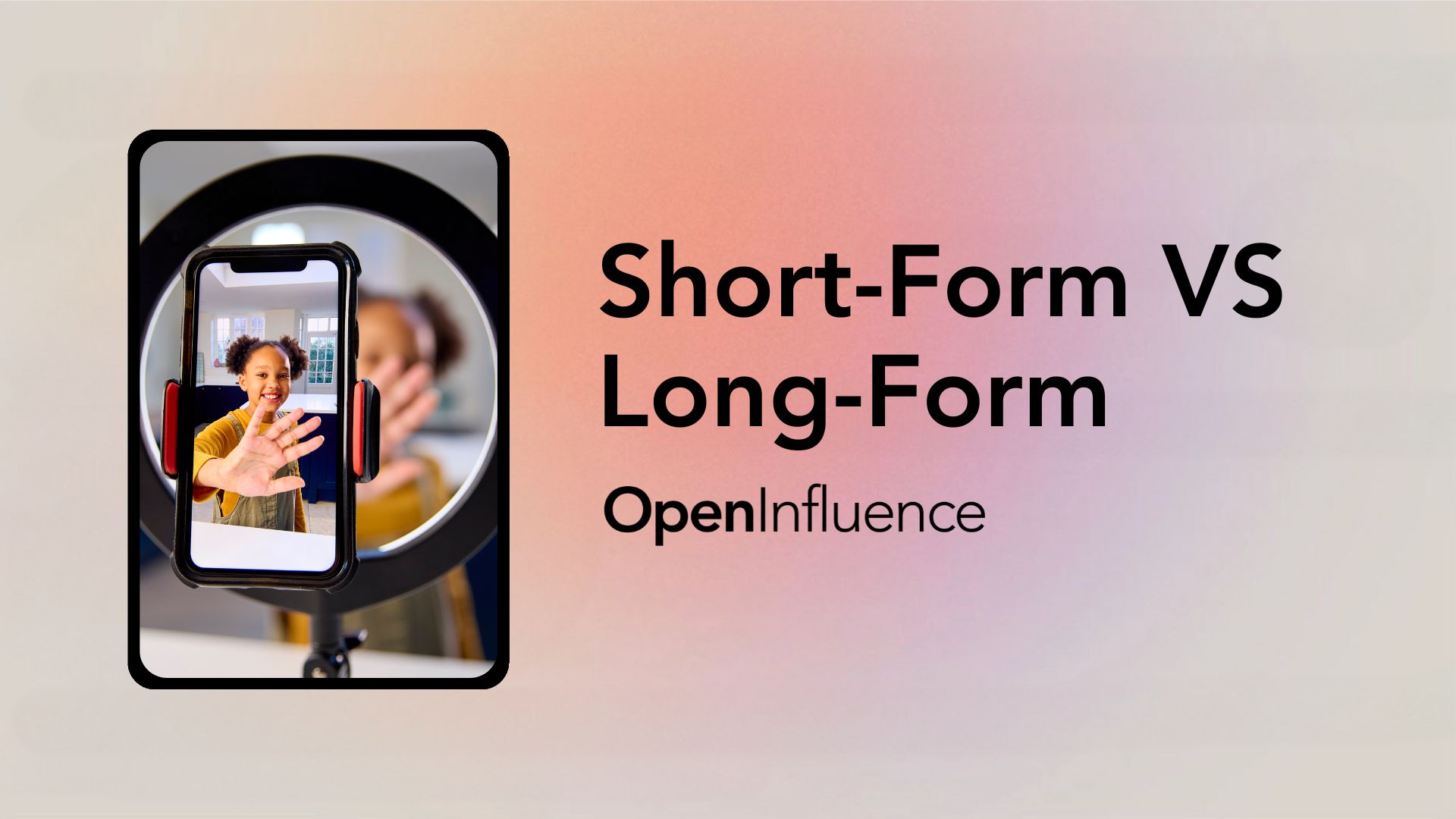Introduction
Vine, an application that let users share looping six-second video clips, had already been around for a little over two years when a much-quoted 2015 study by Microsoft found that humans had an average attention span of eight seconds, or one second shorter than that of a goldfish.
While then-Twitter foolishly pulled the plug on Vine in January 2017, short-form videos found a new home with the emergence of TikTok. And with the copycat nature of social media, other destinations sprouted up, as well, including Facebook and Instagram Reels, and YouTube Shorts.
Short-form videos show no signs of fading away, but humans are beginning to outswim goldfish in the attention pool, as longer-form video is making a comeback of sorts.
“We are shifting from social media to entertainment media,” Open Influence Vice President of Creative and Strategy Alexandra Mathieu said. “People want to stand out in a sea of saturation, and one way to do this is to change formats.”
Even TikTok itself is pivoting, encouraging creators on its platform to post longer videos, and providing financial incentive for those who do.
OI Senior Creative Strategist Zach Honer believes TikTok may be trying to protect itself from relying so heavily on audio-based trends, particularly after losing access to tracks from Universal Music Group artists including Drake, Billie Eilish, Ariana Grande, Olivia Rodrigo, and Taylor Swift when the two companies failed to extend their agreement.
Generation Alpha is a key factor for OI Senior Creative Strategist Gem Garcin, who said, “TikTok doesn’t want to die with Generation Z. YouTube is the go-to platform for younger generations, who are not watching streaming services, but using social media to stream. Longer-form content appeals to Alphas once they are no longer under parental control.”
TikTok Pivots
While TIkTok is obviously not the only platform to host videos, nor is it the only creator marketing option, its strategy shift has been the most jarring development during this long-form content resurgence, as, unlike other platforms, short-form videos had been its foundation.
During an event for creators last October, TikTok revealed that its users were spending roughly one-half of their time on the platform watching videos longer than 60 seconds, and creators posting videos of that length saw a fivefold leap in followers in the six months prior to October.
At another creator meetup that same month, TikTok offered guidance to creators pondering long-form content on its platform, such as reminding them to incorporate something to grab viewers’ attention early on in their videos, as well as providing tips on content types such as challenges, commentary, lifestyle vlogging, tutorials, and vlogs.
Honer believes another reason for the shift is the booming use of TikTok as a search engine, saying, “TikTok is becoming Google for Gen Z, keeping people on the platform longer with new, fresh content. Now, the only dance content you see is actual professional dancers excelling in the category or doing innovative edits. Long-form is a great way to encourage search and diving into these rabbit holes.”
OI Senior Account Manager Jen Thorsheim noted the overhaul of the platform’s Creator Rewards Program, adding, “TikTok’s Creator Fund now only rewards creators for content that is over one minute and meets a variety of other criteria. As a result, the shorter-form content is not being monetized and, thus, there is no incentive for creators to post short-form content.”
After several months in beta, TikTok officially introduced its revamped Creator Rewards Program in March. Videos longer than one minute will be rewarded based on four core metrics:
- Originality: Quality content that is unique to the creator and showcases their point of view or creative thought process in a way that resonates with their community.
- Play duration: The new formula incorporates both watch time and finish rate, with the aim of rewarding accounts for clear and engaging content, rather than number of videos.
- Audience engagement: Comments, likes, and shares.
- Search value: TikTok assigns a value to content based on popular search terms, saying content that aligns with search topics that are in demand is more valuable to users searching on the platform.
Other requirements and points of information about the TikTok Creator Rewards Program include:
- To be eligible, creators must be at least 18, have at least 10,000 followers, have had a minimum of 100,000 views in the past 30 days, and have a personal account in good standing with TikTok.
- Creators will be automatically rewarded for the ad value of their accounts, as determined by the ad watch time of their communities.
- The Creator Rewards Program dashboard was updated with more analytics and data, along with customization options for deeper analysis of how content performed, estimated rewards, qualified views, and program eligibility. Individual videos now have dedicated pages for qualified video views and RPM (revenue per 1,000 qualified views), with detailed information such as explanations, insights, and view trends.
- The in-app monetization module gives creators access to all monetization-related operations, including a detailed revenue analysis of all the ways they are getting paid across the tools they are using, as well as customized insights and personalized recommendations based on the creator’s content.
- A new comprehensive education hub, the Creator Academy, contains articles, courses, insights, resources, and videos for creators of all levels, in seven different languages to start.
Long-Form Content Challenges
Thorsheim pointed out that while TikTok is encouraging creators to produce longer videos, one of its paid best practices for brand partnerships is to keep content under 30 seconds.
“Users have become accustomed to quick, engaging videos that capture attention within seconds on TikTok,” she added. “Long-form videos may struggle to retain user attention, leading to lower viewer retention, completion rates, and engagement metrics. As a result, long-form branded content would need to have key brand or product messaging upfront before viewers drop off.”
Some of the advantages still associated with shorter videos include:
- Brands can use their quick messaging format to communicate critical points in an efficient manner.
- Viewers are more likely to watch shorter videos in their entirety, boosting completion rates and other engagement metrics.
- Short-form video content is still being prioritized by social platforms including Facebook, Instagram, and Snapchat.
- Brands can use shorter videos to test different creative approaches, storytelling techniques, and visual styles without significant investments in resources or time.
OI Senior Account Manager Aundrea Leckie stressed, “There needs to be a level of trust from brands to be able to experiment with long-form content. Many are not willing to give the creative reins to creators to make content that is entertaining enough for people to watch it for that long.”
Garcin added, “Influencer marketing isn’t ready to be long-form yet unless it’s extremely creative and not all sales messaging. There has been some amazing product placement on TikTok inside creative episodes, but brands have to play on ads in the middle of long-form content. How do we capture people’s attention long enough to make it worthwhile to watch?”
On that note, Mathieu chimed in, “Agencies get awards for being the most creative. We should give brands and creators awards.”
Reasons to Opt for Long-Form Content
Longer videos help creators build up their communities, as viewers spend more time consuming their content, keeping them on social platforms for longer periods of time. Types of videos that have worked for creators on this front include discourse and discussion, as well as get ready with me and similar genres.
There are also certain industries that gravitate toward long-form content as the best way to share extensive details about their products and services, such as finance, healthcare, and technology.
Hilton was one of the first brands to strike when TikTok extended its maximum video length to 10 minutes, and its video ad, which used every second of those 10 minutes, racked up over 4 million views in the 48 hours after it debuted last February, with much positive sentiment in the comments section.
Long-form content works for companies of all sizes—even those as large as Amazon, which enlisted creators including Faares Quadri and Vivian Tu to extol the virtues of Amazon Ads.
Other benefits of longer videos include:
- Multiple midroll ads can be included, as opposed to shorter formats like TikTok and YouTube Shorts, where ads appear between videos, resulting in poorer engagement.
- Long-form content helps boost brands’ search-engine-optimization efforts, resulting in higher algorithmic rankings and increased visibility.
- Longer videos usually have a longer shelf life, particularly when they remain relevant, whereas shorter videos tend to generate high rates of traffic immediately, but fizzle shortly thereafter.
- Brands creating long-form content demonstrate a commitment to providing their customers and potential consumers with comprehensive information, helping them stand out versus their competitors and be seen as thought leaders.
- Longer videos can be repurposed into shorter snippets to try to reach more people across more platforms.
- Brands can build a content library of their longer videos, representing a valuable resource for customers and potential customers researching their products and services.
- It makes much more sense fiscally to use high-value production techniques for longer-form content.
“Cable is dead, streaming is expensive, and audiences are choosing to consume entertainment via social media more than ever,” OI Senior Creative Director Sierra Moore said. “Considering those shifts with the fact that there remains endless talent and untapped potential within the creator community, I see a huge opportunity for brands to evolve their creator marketing through high-production entertainment with creators both in front of and behind the camera.”
Using Short-Form to Boost Long-Form
One campaign strategy that has proven to be successful for some brands is using short-form content to promote and drive viewers to longer-form fare.
This works particularly well for podcasts, as creators can share short clips of highlights on platforms such as Facebook and Instagram Reels, TikTok, and YouTube Shorts, including a call to action that brings people to the full-length content on the platform or platforms where it resides.
With YouTube being home to both Shorts and much longer videos, creators on the Google-owned video platform have used Shorts to promote their long-form content, tapping its Remix feature to mine their longer videos for snackable moments.
Creators using this strategy can also link to their longer videos within the description for their Shorts, generating click-throughs for the long-form content.
Don’t Miss Out on Podcasts
Brands can tap creators in the podcasting space for initiatives such as integrating their products or services into the content or collaborating on episodes or segments dedicated to the brand and its offerings, providing rich detail that is impossible to convey via short-form content.
Podcasts are particularly useful in business-to-business marketing, as they are relatively easy and inexpensive to produce. The long-form nature of the medium allows for complex topics to be addressed, and the episodic nature of the medium helps marketers ensure regular and frequent engagement.
Creators can play a role by promoting individual episodes or the entire podcast to their loyal audiences across several platforms.
The finance industry has embraced the medium as part of creator marketing campaigns, as OI and Havas worked with Fidelity on two such campaigns.
One tapped actress, author, podcast host, and onetime Jeopardy! host Mayim Bialik, who helped give the company a more human face while encouraging listeners and viewers to plan for significant life events and the future.
And the second urged people to plan their retirement, with participation from five creators: Tara Clark, Natalie Lee, father-daughter duo Nick and Sienna, June Quan, and Denise Vasi.
Best Practices for Long-Form Content
The most important things to remember when crafting longer videos in creator campaigns are bringing the brand to the forefront very early on—within the first 15 seconds—to grab the viewer’s attention, but also ensuring that the remainder of the video provides value to the viewer and does not merely serve as a commercial or infomercial for the brand and its products or services.
Other best practices include:
- Remain authentic, and don’t chase trends when they have nothing to do with the field your brand is in.
- Ensure that your content can be adapted for various platforms and surfaces for maximum exposure.
- Think visual: Graphics, infographics, or video clips from longer videos can be shared on visually driven platforms such as Instagram and Pinterest to introduce viewers to the full content.
- Try to establish an emotional connection, with creators speaking to their viewers the way they would speak with their friends.
- In some cases, it makes sense to break longer videos into multiple parts, or serialize them, with the hopes of generating anticipation for new installments and return visits.
- Add interactive elements such as calls to action, polls, or questions, which not only drives an uptick in engagement, but also gives brands access to feedback and insights from their audience.
- Create discussion threads based on long-form content in online communities and groups, further fostering engagement.
- Finally, while, as stated earlier, long videos that come across as too pushy will not be successful, finding ways to place products within those videos authentically and organically is a challenge brands and creators must embrace.
“I think we have to figure out how we capture people’s attention long enough to make it worthwhile to watch, so I do think it has to be inside of these creative plays, with product placement or something like that, versus the whole thing being like a sales pitch,” Garcin said.
OI Director of Partnerships Jessica Tobey agreed, adding, “What feeds into what we’re talking about here is product placement, but more organic weaving in a story that becomes more organic while weaving in the product. So, it’s more than product placement—it’s entertainment.”
Open Influence’s team stays on top of the latest trends and is here to help you maximize your creator campaigns. Open Influence is a leading global creator marketing agency dedicated to creating engaging campaigns.






